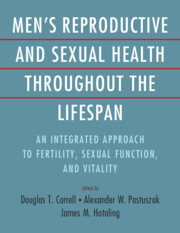 Men's Reproductive and Sexual Health Throughout the Lifespan
Men's Reproductive and Sexual Health Throughout the Lifespan Book contents
- Men’s Reproductive and Sexual Health throughout the Lifespan
- Men’s Reproductive and Sexual Health throughout the Lifespan
- Copyright page
- Contents
- Contributors
- Preface
- Section 1 An Introduction to Men’s Health Care
- Section 2 The Biology of Male Reproduction and Infertility
- Chapter 4 Current Understanding of the Physiology and Histology of Human Spermatogenesis
- Chapter 5 Male Reproductive Endocrinology
- Chapter 6 Sperm Chromatin Packaging and the Toroid Linker Model
- Chapter 7 Ejaculation and Sperm Transport
- Chapter 8 Genetic Aspects of Male Infertility
- Chapter 9 The Mechanistic and Predictive Utility of Sperm Epigenetics
- Chapter 10 Aging and Environmental Interactions with the Sperm Epigenome
- Chapter 11 The Effects of Aging on Male Fertility and the Health of Offspring
- Section 3 Clinical Evaluation and Treatment of Male Infertility
- Section 4 Laboratory Evaluation and Treatment of Male Infertility
- Section 5 Medical and Surgical Management of Issues of Male Health
- Index
- References
Chapter 8 - Genetic Aspects of Male Infertility
from Section 2 - The Biology of Male Reproduction and Infertility
Published online by Cambridge University Press: 06 December 2023
- Men’s Reproductive and Sexual Health throughout the Lifespan
- Men’s Reproductive and Sexual Health throughout the Lifespan
- Copyright page
- Contents
- Contributors
- Preface
- Section 1 An Introduction to Men’s Health Care
- Section 2 The Biology of Male Reproduction and Infertility
- Chapter 4 Current Understanding of the Physiology and Histology of Human Spermatogenesis
- Chapter 5 Male Reproductive Endocrinology
- Chapter 6 Sperm Chromatin Packaging and the Toroid Linker Model
- Chapter 7 Ejaculation and Sperm Transport
- Chapter 8 Genetic Aspects of Male Infertility
- Chapter 9 The Mechanistic and Predictive Utility of Sperm Epigenetics
- Chapter 10 Aging and Environmental Interactions with the Sperm Epigenome
- Chapter 11 The Effects of Aging on Male Fertility and the Health of Offspring
- Section 3 Clinical Evaluation and Treatment of Male Infertility
- Section 4 Laboratory Evaluation and Treatment of Male Infertility
- Section 5 Medical and Surgical Management of Issues of Male Health
- Index
- References
Summary
Approximately one out of every 15 men will exhibit subfertility or infertility, and some data suggest the incidence of male infertility is increasing. While a number of factors can cause male infertility, there is strong and growing evidence that genetic factors contribute to a significant proportion of cases. Several significant genetic factors have long been recognized as clinically relevant causes of male infertility including Klinefelter syndrome, microdeletions of the Y chromosome, and cystic fibrosis transmembrane conductance regulator mutations. Since the discovery of these factors in the 1950s, 1970s, and 1980s respectively, there has been a relative dearth in the discovery of additional clinically relevant genetic factors underlying male infertility until recently. However, with the application of emerging genome-wide genetic approaches, along with the collaborative efforts from a growing number of groups, male infertility genetics has experienced a renaissance of sorts in the past decade with significant new discoveries being reported frequently over recent years. This chapter will briefly review the history of male infertility genetics as well as some of the more recent discoveries and efforts beyond gene screening approaches that have and will continue to advance the field.
Keywords
- Type
- Chapter
- Information
- Men's Reproductive and Sexual Health Throughout the LifespanAn Integrated Approach to Fertility, Sexual Function, and Vitality, pp. 67 - 75Publisher: Cambridge University PressPrint publication year: 2023
